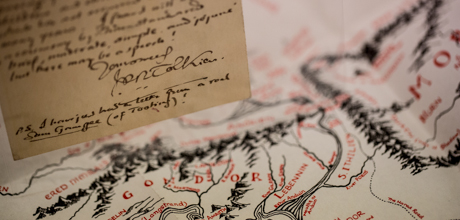by Laura Donnelly-Smith
J.R.R. Tolkien’s Middle-earth may seem closer than ever before for the George Washington University community, thanks to rare first editions of Mr. Tolkien’s famous books, “The Hobbit” and “The Lord of the Rings,” which are available for use in Estelle and Melvin Gelman Library’s Special Collections Research Center.
The recently released film “The Hobbit: An Unexpected Journey” has generated a new surge of interest in Mr. Tolkien’s works, which have enjoyed immense popularity for decades—“The Lord of the Rings” is the best-selling novel ever written. And the editions in Gelman’s seventh-floor Special Collections Research Center are of special interest both to scholars and to more casual Tolkien fans, said Jenny Kinniff, public services and outreach librarian for Special Collections.
First editions of each of book—dated 1937 for “The Hobbit” and 1954 and 1955 for the books in the “Rings” trilogy—have been part of the university’s collection for many decades, Ms. Kinniff said. They came to the library via donation.
“First editions are useful for scholars to see an author’s original intent, before edits that are sometimes made in subsequent editions,” Ms. Kinniff explained. For example, a reader familiar with “The Hobbit” from a modern paperback edition would find substantial differences if he or she sat down to read the 1937 edition in the Special Collections Research Center. The author edited “The Hobbit” for later editions to make its content better correspond with events in the “Rings” trilogy (for which “The Hobbit” is a prequel).
Inside the dust jacket of the first book in the trilogy, “The Fellowship of the Ring,” is a handwritten note from Mr. Tolkien to E. Rasdall, Esq., dated March 21, 1956. The text reads:
I am so sorry! Your parcel arrived safely, but it arrived at a crowded time, and I was also unwell. In fact, I had to go away to recuperate, and only returned yesterday. It was on my conscience that I had gone off without either returning your books or letting you know. I will send them off, I hope on Friday. Why not at once? Well, because tomorrow my wife and I celebrate our 40th or ruby wedding anniversary, and are preparing for the gathering of our children and children-in-law, which has not occurred complete for many years. I fear it will be a ceremony by Shire standards ‘brief, moderate, simple, and jejune’ but there may be a speech!
Yours truly, J. R. R. Tolkien
P.S. I have just had a letter from a real Sam Gamgee (of Tooting)!
“It’s a bit of a puzzle as to who [Rasdall] is and how the letter got into the book,” Ms. Kinniff said. The book is inscribed with a name and date on the inside cover—Christine Cusnich, August 1954—but nothing is known about Ms. Cusnich, and little is known about Mr. Rasdall, aside from the fact that he was most likely a book collector.
Gelman Library staff members wrote a blog post about the first editions, hoping to spread the word about them and, perhaps, to pique the interest of someone who might shed light on the mystery of Mr. Tolkien’s handwritten note. But the books are equally fascinating for those without background knowledge who simply love the world Mr. Tolkien created.
Assistant Professor of English Jonathan Hsy, who teaches a course called “Epic and Romance: When Worlds Collide” about how literary texts reconcile different worlds coming into conflict, said there are numerous reasons why Mr. Tolkien’s work is still so compelling to so many.
“Tolkien imbues his fictional world with rich, vivid detail, and the stories he tells—which often feature quests, adventure and a triumph of forces of good over evil—resonate with readers across different cultures and age groups,” he said.
Mr. Tolkien was an academic as much as he was an author, Dr. Hsy said, and the complex world he created in Middle-earth was based at least in part on his training as a linguist, as well as his knowledge of medieval literature.
“The fictional Elvish languages he constructed drew features of their grammar and sound structure from real human languages like Welsh and Finnish; the Riders of Rohan have names drawn from Anglo-Saxon literature; and Tolkien’s dwarves show characteristics derived from Norse mythology,” Dr. Hsy explained. “By interweaving these diverse older traditions into a new form, Tolkien gave his fictional storytelling a striking level of depth and reality.”
In 1939, Mr. Tolkien delivered a lecture, which was later published, titled “On Fairy Stories.” It defended the literary genre of fairy stories, which might now be called fantasy.
“He argued that fantasy writing creates a compelling alternate reality or ‘Secondary World’ that always resonates with the ‘Primary World,’ or the lived reality of the readers,” Dr. Hsy said. “I think one reason Tolkien’s work is so appealing and enduring is that people can interpret his rich ‘Secondary World’ in any number of ways.”
Many readers have interpreted Mr. Tolkien’s description of how the Ents, the ancient tree-like creatures in the “Rings” trilogy who have lost their Entwives, or mates, as a commentary on environmental degradation., Dr. Hsy said. But this is only one interpretation.
“There isn’t one right reading for Tolkien’s stories, and ultimately audiences are free to engage with his works on their own terms, creating new meanings and finding other points of connection to their own lives,” he said.
Anyone is welcome to see the books—whether working on research, like a master’s student who recently visited, or simply an interested reader. While the books don’t circulate, library patrons are able to examine them close up or even read a few chapters.
“These things are here to be used,” Ms. Kinniff said. “We feel very strongly about that.”


